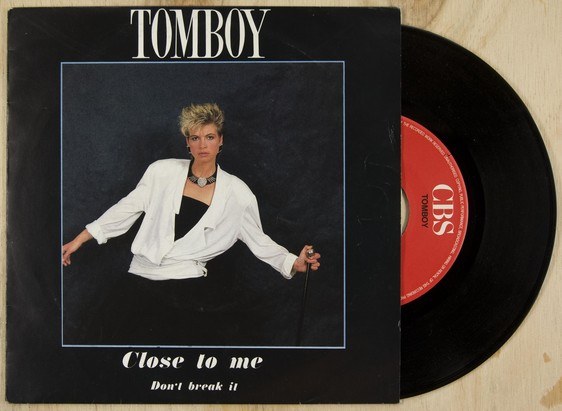
Tomboy 7″ – Her er det B-siden som er best (foto fra Bergen Bibliotek)
Tomboy
Close to Me/Don’t Break It
CBS Records: CBSA 6568
Tomboys Close to me er en helt grei låt, men for meg var det B-siden av singelen, Don`t break it som var det store.
Jeg har spilt den mang en natt på nærradio på 80-tallet, og jeg har aldri reflektert noe mer over den låten annet en at det er en super nattlåt.
Så her om dagen mens jeg tilfeldigvis lyttet til den tenkte jeg å sjekke hvem hva hvor om den låten.
For de som husker Tomboy fra 80-tallet vil kanskje den engelskinspirerte produksjonen, og utstrakte bruk av synther.
Nå trenger jeg ikke å skrive noe om det, siden det finnes masse informasjon om dette på nett. Men du skal få noen pekere av meg, såpass bør jeg tilby.
Først musikalske.net artikkel om Tomboy, anbefales som en liten historisk reise tilbake til den gangen RAM var dyrt.
Lenke til Discos informasjon om denne singelen finner du her. Og selvfølgelig en side som handler om bandet til Murray Munro som produserte mye av musikken til Tomboy. Han er ikke Trevor Horn, selv om han til tider likte å sammenligne seg litt med ham. Noe som også gjenspeilte seg i den musikalske «krigen» mellom Mainframe og The Art Of Noise. Sjekk ut nettstedet om Mainframe.
Wikipedia
Tidligere hadde wikipedia en artikkel om Mainframe, men siden om dem ble slettet i 2015, men her er en kopi:
Mainframe was an Electropop band from Hemel Hempstead, 26 miles north of London, England. Formed in 1982, it comprised two main members, unknown musicians Murray Munro (born 1963) and John Molloy (born 1960). The former was already working with a new, small, independent record company named mc2 Music (taken from the famous Albert Einstein equation), also based in Hemel Hempstead. Murray Munro fronted an earlier band actually called mc2. The band released an album entitled «Relatively Speaking….» in early 1980 which was the first record released on the mc2 Music label (catalogue # MC001).
The deal with mc2 saw the production of a number of single vinyl records, one of which comprised some simple graphically-oriented programmes for popular home computers of the era (The consumer was required to cable a turntable and amplifier to the cassette audio input of his/her computer.)
In September 1983 Mainframe issued a concept album entitled Tenants of the Lattice-Work which met with some success.
The popularity of avant-garde band The Art of Noise prompted Mainframe to retort with a 12-inch single entitled «Into Trouble with the Noise of Art», released by mc2 offshoot Ying Yang Yumm, undoubtedly a cheeky reference to the Art of Noise’s own label Zang Tuum Tuum (aka ZTT) and their debut EP Into Battle with the Art of Noise.
The following year the Art of Noise released «Close (To the Edit)», and Mainframe responded with a second 12-inch single, «Close (To the Ground) – the C5 edit», a reference to the Sinclair C5 personal electric vehicle.
mc2 Music folded in 1984 and the band was picked up by Polydor’s dance label offshoot Boiling Point who released 7-inch and 12-inch single versions of «5 Minutes». Achieving minor and brief success, Murray and John branched out into music technology, having already played key roles in developing the Greengate DS3 sound card system which turned an Apple II home computer into a complex polyphonic sound sampler / percussion unit.
Mainframe took part in an edition of the BBC science programme The Show Me Show (broadcast 14 September 1983) wherein they played a specially-composed new track entitled «The Bubble Diver». This piece never acquired an official release.
The group also participated in the BBC’s Breakfast Time programme (8 July 1985) and pop-music show Juice (broadcast 15 January 1986).
Despite their profile in the media, Murray and John were unable to maintain further commercial success and Mainframe was officially disbanded in 1986 after Polygram refused to issue any further Mainframe releases. The contract, however, meant that Murray and John could not continue careers as recording artists on another label.
Throughout the 1980s John Molloy occasionally contributed articles for magazines such as Computer and Video Games, and created the interactive fiction game «Fish» for Magnetic Scrolls. The game was accompanied by a cassette with music by John. He also performed live at a number of small electronic music events, and worked as a music producer for a number of bands, none of whom became famous.
Munro produced the album «Shadows on the Wall» for the Norwegian band Tomboy in 1988, together with the band’s main songwriter and keyboardist Per Hansmark. Other than that, little is known of Murray Munro’s post-Mainframe activities other than his extensive composition work for library music label Atmospheres.
Singles
Radio (Will Bring Me Home) / The Room (Part 2) (1983, mc2 Music, catalogue # MC004)
Talk to Me / programs for Apple II, Sinclair ZX81, Sinclair ZX Spectrum and BBC Micro home computers (1983, mc2 Music, catalogue # MC005)
Into Trouble With the Noise of Art / Sex / War / Religion / Noise from China / Noise of Peter / Last Chords (1984, mc2 Music, catalogue # YYY001)
«Close (To The Ground) — The C5 Edit / The Print of Death» (1985, mc2 Music, catalogue # YYY002)
5 Minutes / Eric’s Revenge (1985, Polydor, catalogue # MAIN1) – UK No. 92, NL No. 32
5 Minutes On (1985)
5 Minutes On (1986) – (re-issue))
Albums
MC2 – Relatively Speaking…. (1980, mc2 Music. Private pressing, catalogue # MC001)
Tenants of the Lattice-Work (1983, mc2 Music, catalogue # MC007)